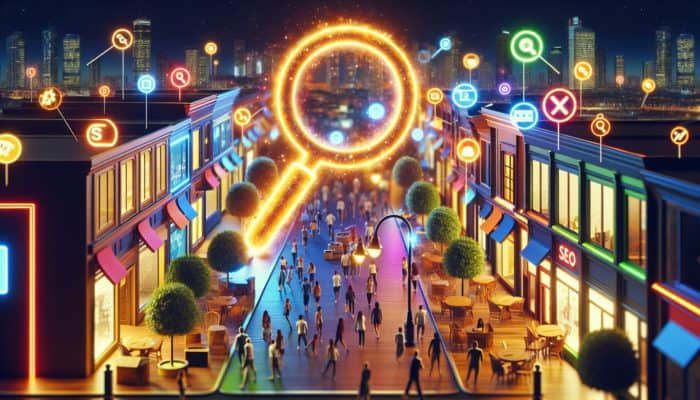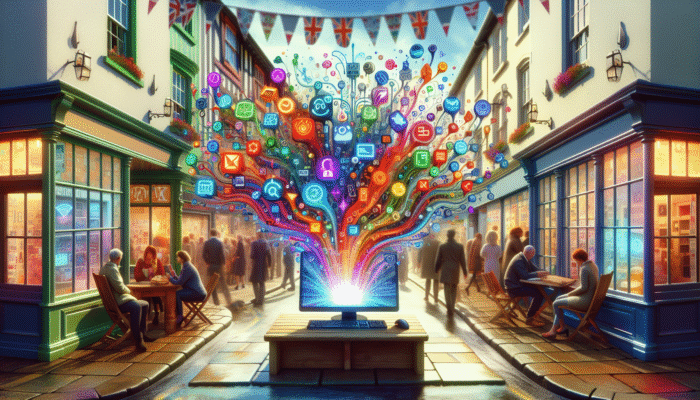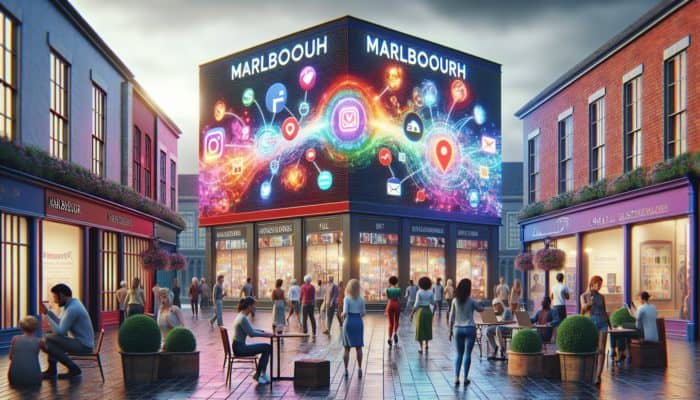Table of Contents
ToggleHarnessing Creativity: Key Features of Leading Marketing Agency Websites
The field of marketing is dynamic and ever-evolving, and the leading marketing agency websites embody the latest trends and best practices. These websites function beyond mere digital brochures; they serve as dynamic platforms aimed at captivating, educating, and converting potential clients into loyal consumers. This analysis delves into the essential features that foster innovation, contemporary design trends, superior user experiences, and robust content strategies employed by top-tier agencies to engage their audiences effectively.
Engaging Design Trends to Elevate Marketing Agency Websites
The design of a website is pivotal in forming a marketing agency’s initial impression on prospects. Today, the leading marketing agency websites adopt engaging design trends that not only attract visitors but also communicate their brand identity effectively. Minimalism stands out as a significant trend, characterised by streamlined layouts and ample white space. This approach allows users to focus on the content, free from distractions, thereby enhancing both aesthetic appeal and loading speeds—critical factors for maintaining user interest.
Additionally, bold typography is gaining prominence. Agencies are increasingly opting for large, striking fonts that convey their messages quickly and efficiently. This shift towards visual storytelling transforms written words into immersive experiences. Moreover, the incorporation of bespoke illustrations and animations enriches user interaction, making the website not only memorable but also unique.
The emergence of dark mode interfaces is another noteworthy trend, offering a striking contrast that highlights essential elements on the page. This modern design choice appeals to a tech-savvy audience, conveying sophistication. Furthermore, responsive design remains a fundamental requirement, ensuring that leading marketing agency websites provide a seamless experience across all devices, from desktops to smartphones.
The color schemes employed on agency websites significantly influence brand perception as well. Agencies experiment with vibrant colors and gradients to evoke feelings of energy and excitement. When these design components are paired with strategically positioned calls-to-action (CTAs), they can markedly enhance user engagement and boost conversion rates.
Delivering Exceptional User Experiences on Agency Websites
User experience (UX) is a crucial factor in the digital realm, particularly for the leading marketing agency websites. A well-crafted UX promotes positive interactions, resulting in increased engagement and higher conversion rates. Top agencies prioritise UX by adhering to user-centric design principles, ensuring that every element of the site serves a distinct purpose.
A critical element of UX is the website’s navigation architecture. Premier agencies deploy clear and logical navigation systems that enable users to locate information swiftly and efficiently. Features like dropdown menus, breadcrumb navigation, and search functionalities are essential components that significantly enhance usability. A well-organised site not only improves user satisfaction but also positively influences SEO performance.
Loading speed remains another vital consideration. Research shows that users are likely to abandon websites that take longer than a few seconds to load. Agencies enhance loading speeds by optimising images, employing caching methods, and minimising server response times. While these technical optimisations may go unnoticed, they are crucial for retaining visitor engagement.
Moreover, accessibility stands as a key aspect of contemporary web design. The leading marketing agency websites adhere to web content accessibility guidelines (WCAG), ensuring their sites can be navigated by individuals with disabilities. This dedication widens the agency’s audience and enhances its reputation as an inclusive brand.
Agencies are increasingly leveraging data analytics to continually refine the user experience. By analysing user behaviour through heat maps and session recordings, they can identify pain points and optimise their sites accordingly. This iterative process ensures that the website evolves in alignment with user expectations and industry best practices.
Implementing Strategic Content Approaches for Agency Homepages
The content presented on a marketing agency’s homepage serves as the initial touchpoint for potential clients. The leading marketing agency websites adopt effective content strategies that clearly and persuasively articulate their value propositions. Engaging headlines and subheadings are essential; they capture attention and navigate visitors through the content seamlessly.
Storytelling has emerged as a compelling technique that agencies employ to create connections with their audiences. By sharing their brand stories, missions, and core values, agencies cultivate emotional connections. This authentic storytelling fosters trust and establishes a sense of reliability among potential clients.
Integrating visuals alongside written content can significantly enhance user interaction. Elements like infographics, videos, and detailed case studies break up the text and offer valuable insights into the agency’s capabilities. These components not only make the content more digestible but also showcase the agency’s expertise effectively.
Strategically placing calls-to-action (CTAs) throughout the homepage is crucial to guiding users toward desired actions, such as requesting a consultation or subscribing to a newsletter. Effective CTAs are clear, concise, and visually prominent, ensuring potential clients understand the next steps to take.
Additionally, agencies are increasingly focusing on search engine optimisation (SEO) strategies to enhance content visibility. By incorporating relevant keywords and phrases, optimised agencies can improve their search engine rankings and attract more organic traffic.
Effective content strategies are foundational to the leading marketing agency websites. By blending narrative, visuals, and strategic CTAs with SEO best practices, agencies can communicate their unique value propositions eloquently and engage potential clients effectively.
Recognising Key Features of the Most Successful Marketing Agency Websites

When assessing the leading marketing agency websites, several key features stand out as indicators of quality and effectiveness. These features not only enhance user experience but also play a vital role in the agency’s ability to attract and convert clients. In this analysis, we will explore seamless navigation, compelling case studies, and the integration of SEO and digital marketing tools.
Establishing Seamless Navigation and Structure for Agency Websites
Seamless navigation is a defining characteristic of the leading marketing agency websites. A well-structured site facilitates easy access to information, allowing users to transition smoothly between pages. This is especially important for agencies that offer a wide range of services. Clear headings and subheadings, along with a logical hierarchy, help visitors quickly find the information they need.
Top agencies often implement sticky navigation bars that remain visible as users scroll down the page. This design choice ensures that critical information is always accessible, significantly enhancing usability. Furthermore, incorporating a search function can improve the user experience by allowing visitors to locate specific content without navigating through multiple pages.
Breadcrumb navigation is another effective tool that provides users with a clear path throughout the website, enabling them to backtrack easily. This feature is particularly beneficial for larger websites that host multiple service offerings.
Mobile optimisation is vital, as a growing number of users access websites via smartphones or tablets. The leading marketing agency websites ensure that their navigation is seamlessly translated to mobile devices, featuring touch-friendly buttons and simplified layouts. This commitment to mobile usability enhances user satisfaction and positively impacts search engine rankings.
In summary, seamless navigation and a well-structured site are foundational elements that contribute to the effectiveness of a marketing agency’s website. By prioritising user experience, agencies can significantly enhance engagement and drive conversions.
Utilising Compelling Case Studies and Client Testimonials for Credibility
Client testimonials and case studies serve as powerful instruments for building trust and credibility on the leading marketing agency websites. These elements act as social proof, showcasing the agency’s capacity to deliver results and meet client needs. When potential clients observe tangible evidence of success, they are more likely to engage.
Effective case studies address the specific challenges faced by clients, the solutions implemented by the agency, and the measurable outcomes achieved. This narrative format not only highlights the agency’s expertise but also positions them as proficient problem solvers. Including visuals such as graphs, before-and-after images, or video testimonials can significantly amplify the impact of these case studies.
Client testimonials should be strategically positioned throughout the website, particularly on the homepage and service pages. Short, impactful quotes that capture the essence of the client’s experience can resonate deeply with visitors. Additionally, featuring well-known brand names as clients can enhance credibility and capture attention.
Creating a dedicated section for testimonials and case studies can further reinforce authority. Agencies should consider categorising these success stories by industry or service type, making it easier for potential clients to find relevant examples. This targeted approach can significantly boost the likelihood of conversion as prospects see their specific needs addressed.
Compelling case studies and testimonials are essential for the leading marketing agency websites. They not only build trust but also demonstrate the agency’s ability to achieve significant results for its clients, fostering confidence among potential customers.
Incorporating SEO and Essential Digital Marketing Tools for Enhanced Visibility

Incorporating SEO and digital marketing tools has become indispensable for leading marketing agency websites in today’s digital landscape. These tools not only enhance visibility but also facilitate data-driven decision-making. Agencies that harness these technologies gain a deeper understanding of their audience, optimise strategies, and improve overall performance.
SEO serves as the backbone for driving organic traffic. The leading marketing agency websites integrate on-page SEO techniques, including keyword optimisation, meta tags, and alt text for images. Regularly updating content with relevant keywords is vital for improving search engine rankings and attracting more visitors.
Furthermore, integrating tools like Google Analytics allows agencies to monitor user behaviour and site performance. By analysing metrics such as bounce rates, session duration, and conversion rates, agencies can pinpoint areas for improvement and adjust their strategies accordingly. This data-driven approach ensures agencies remain agile and responsive to market shifts.
Social media integration is another crucial element. The leading marketing agency websites often include links to their social media profiles, encouraging visitors to engage with them across various platforms. This cross-channel approach not only enhances brand visibility but also fosters community and connection with potential clients.
Email marketing tools can also be seamlessly integrated into agency websites. By offering valuable content downloads or newsletter subscriptions, agencies can build their email lists and nurture leads over time. This ongoing engagement is vital for converting prospects into loyal clients.
In summary, integrating SEO and digital marketing tools is essential for the leading marketing agency websites. By employing these strategies, agencies can enhance their online presence, optimise user engagement, and drive conversions.
Insights from Industry Leaders on Creating Effective Marketing Agency Websites
Gaining insights from industry leaders offers valuable perspectives on the elements that contribute to a marketing agency’s website success. This section will explore interviews with top agency founders, case studies of impactful website redesigns, and current trends influencing agency website development.
Key Insights from Founders of Top Marketing Agencies
Interviews with the founders of leading marketing agencies reveal the strategies and thought processes that underpin their successful websites. These industry leaders often stress the significance of authenticity and clarity in messaging. They assert that the leading marketing agency websites effectively reflect their unique value propositions while nurturing strong connections with their target audiences.
Many founders highlight the importance of user feedback in shaping their websites. By actively seeking input from clients and users, agencies can identify pain points and areas that require enhancement. This iterative process not only improves user experience but also aligns the website with the changing needs of its audience.
Another recurring theme in these interviews is the balance between aesthetics and functionality. Founders emphasise that while a visually appealing design is crucial, usability must never be compromised. The leading marketing agency websites prioritise user experience, ensuring that visitors can navigate effortlessly and locate the information they seek.
Moreover, many founders discuss the importance of continuous learning in website development. Staying informed about the latest design trends, SEO practices, and user experience principles is essential for maintaining a competitive edge. They encourage agencies to invest in ongoing education and training for their teams to foster a culture of innovation.
Overall, insights from industry leaders underscore the significance of authenticity, user feedback, and a commitment to continuous improvement in developing successful agency websites.
Case Studies of Impactful Website Redesigns
Examining case studies of successful website redesigns provides real-world examples of how strategic changes can dramatically impact a marketing agency’s performance. One notable case involved a well-established agency that recognised its website as outdated and unrepresentative of its brand identity.
The redesign focused on modernising aesthetics while enhancing functionality. The agency adopted a minimalist design, leveraging generous white space and bold typography to create a contemporary look. They also improved site navigation, incorporating interactive elements such as hover effects and animations to engage users.
Post-redesign, the agency experienced a significant increase in website traffic and user engagement. The improved user experience led to a higher conversion rate, with more visitors reaching out for consultations. This case illustrates how a thoughtful redesign can rejuvenate an agency’s online presence and yield tangible business results.
Another case study involved an agency aiming to better showcase its portfolio and case studies. The redesign emphasised storytelling, presenting each project as a narrative detailing the challenges faced, solutions implemented, and outcomes achieved. This approach not only enhanced engagement but also positioned the agency as a thought leader within its industry.
These case studies highlight the importance of aligning website design with strategic business goals. By prioritising user experience and storytelling, agencies can create compelling websites that resonate with their target audiences and drive conversions.
Current Trends Influencing Agency Website Development
Staying abreast of trends in agency website development is crucial for remaining relevant in a competitive landscape. One significant trend is the rise of personalisation. The leading marketing agency websites harness data to create tailored experiences for visitors. By analysing user behaviour and preferences, agencies can present customised content that resonates with individual users.
Another trend is the integration of artificial intelligence (AI) and chatbots. These technologies enhance user engagement by offering instant support and information. Agencies utilize chatbots to address common inquiries, guide users through their services, and even schedule consultations. This level of interactivity boosts user satisfaction and streamlines agency operations.
Mobile-first design is gaining traction as well. With a growing number of users accessing websites via mobile devices, agencies prioritise mobile optimisation in their development strategies. This approach ensures that websites are responsive and user-friendly across all screen sizes, ultimately enhancing the overall user experience.
Finally, agencies are embracing the philosophy of continuous improvement. Rather than viewing website development as a one-off project, leading agencies adopt an iterative approach, regularly updating and optimising their sites based on user feedback and performance data. This commitment to ongoing enhancement guarantees that websites remain relevant and effective in achieving business objectives.
In conclusion, trends in agency website development emphasise personalisation, AI integration, mobile optimisation, and a commitment to continuous improvement. By staying attuned to these trends, agencies can create websites that not only attract visitors but also foster meaningful engagement and conversions.
Making the Right Choice: A Comprehensive Guide to Selecting a Marketing Agency
Choosing the right marketing agency is a critical decision that can significantly influence your business outcomes. The leading marketing agency websites provide insights into the agency’s expertise, portfolio, and culture. This discussion will delve into how to evaluate agency expertise, assess their portfolio, and comprehend the significance of agency culture and values.
Evaluating Agency Expertise and Areas of Specialisation
Assessing an agency’s expertise and specialisation is crucial when perusing the top marketing agency websites. This can typically be discerned through the services offered and the clarity with which they are presented. Agencies that effectively communicate their areas of specialisation—such as SEO, content marketing, or social media management—demonstrate a clear understanding of their strengths.
Look for comprehensive descriptions of services, ideally accompanied by case studies or examples of past work. This not only provides insight into the agency’s capabilities but also illustrates their experience across specific industries. A strong agency website often features dedicated sections for various services, outlining methodologies and results achieved.
Another essential factor is the credentials and experience of the agency’s team. The leading marketing agency websites frequently include bios of key team members, showcasing their backgrounds, expertise, and roles. This transparency fosters trust and instills confidence in potential clients regarding the agency’s ability to deliver results.
Furthermore, consider the agency’s thought leadership. Many top agencies maintain a blog or resource section where they share insights, industry trends, and expert opinions. This content not only highlights their knowledge but also positions them as authorities in their field.
By thoroughly evaluating these aspects, you can ascertain whether an agency’s expertise aligns with your marketing needs.
Assessing the Agency’s Portfolio and Previous Work
A well-curated portfolio is a cornerstone of the leading marketing agency websites. It showcases the agency’s capabilities and demonstrates its ability to deliver results across various projects. When examining an agency’s portfolio, look for diversity in the types of projects and industries served.
Top agencies often feature case studies that detail specific projects, outlining the challenges faced, strategies implemented, and results achieved. This narrative structure provides context and helps potential clients grasp the agency’s problem-solving abilities. Additionally, metrics that quantify success, such as increased traffic, improved conversion rates, or heightened brand awareness, are invaluable.
It’s vital to evaluate the quality of the showcased work. Strong visuals, compelling copy, and innovative solutions indicate high creativity and expertise. Pay attention to the consistency of branding and messaging across different projects; this can provide insight into the agency’s ability to maintain a cohesive client identity.
Moreover, testimonials and feedback from previous clients should also be considered in the portfolio. Positive endorsements can enhance credibility and reassure potential clients of the agency’s track record of delivering exceptional results.
In summary, thoroughly assessing an agency’s portfolio and past work is crucial for determining whether they are the right fit for your marketing needs. A robust portfolio not only showcases the agency’s capabilities but also builds trust and confidence in their expertise.
Understanding the Significance of Agency Culture and Values
The culture and values of a marketing agency greatly influence your choice to partner with them. The leading marketing agency websites often reflect the agency’s culture through their messaging, design, and content. Understanding an agency’s values can help ensure alignment with your business goals and ethics.
Look for indicators of the agency’s culture on its website. This may include statements about its mission, vision, and core values. Many top agencies feature team photos, behind-the-scenes content, or employee testimonials, providing a glimpse into their work environment.
Consider the agency’s approach to collaboration and client relationships. Agencies that prioritise transparency, communication, and partnership often achieve more successful outcomes. Look for signs that the agency values client feedback and is open to adapting its strategies based on your needs.
Moreover, agency culture can significantly impact creativity and innovation. A positive, inclusive work environment often fosters creativity, leading to more effective marketing solutions. The leading marketing agency websites articulate how their culture influences their work and the results they deliver for clients.
Understanding an agency’s culture and values is vital for a successful partnership. By selecting an agency whose values align with yours, you can cultivate a collaborative relationship that drives results.
Examining Practical Use Cases and Illustrative Examples of Marketing Agency Websites
Understanding how the leading marketing agency websites attract clients can unveil valuable insights into effective strategies. This section will explore practical use cases, showcasing how agencies leverage their websites to convert visitors into clients, highlight niche expertise, and implement multi-language strategies for broader reach.
Strategic Approaches Agencies Use to Attract Clients via Their Websites
Effective website utilisation is fundamental for marketing agencies aspiring to attract clients. The leading marketing agency websites employ a variety of strategies to engage visitors and guide them toward conversion. One primary tactic involves the use of lead magnets—valuable resources offered in exchange for contact information, such as eBooks, whitepapers, or free consultations.
Additionally, agencies often utilise landing pages specifically designed for promotional campaigns. These pages focus on a single offer, minimising distractions and increasing conversion likelihood. Clear, persuasive copy combined with striking visuals can significantly enhance the effectiveness of these pages.
Case studies and testimonials play a crucial role in building credibility and trust. By showcasing successful projects and satisfied clients, agencies instill confidence in potential clients. This social proof often serves as the final nudge required to convert visitors into leads.
Furthermore, agencies invest in content marketing strategies that drive organic traffic to their websites. By producing high-quality blog posts, videos, and infographics, agencies position themselves as thought leaders within their industries. This approach not only attracts potential clients but also enhances the agency’s SEO performance.
In conclusion, the leading marketing agency websites effectively leverage lead magnets, landing pages, social proof, and content marketing to attract clients and drive conversions.
Highlighting Niche Expertise Through Agency Websites
Agencies focusing on niche markets often use their websites as platforms to showcase their unique expertise. The leading marketing agency websites in niche sectors effectively communicate their distinct value propositions and demonstrate their understanding of specific industries.
For example, an agency specialising in healthcare marketing might include case studies that illustrate its experience working with medical professionals. By detailing the sector-specific challenges faced and the innovative solutions implemented, it positions itself as an expert in healthcare marketing.
Moreover, these agencies frequently create tailored content that speaks directly to their target audiences. This could include blog posts, whitepapers, or webinars that tackle industry-specific challenges and trends. By providing valuable insights, these agencies establish themselves as trusted resources within their niche.
Additionally, effective use of visuals can further highlight niche expertise. Infographics, videos, and industry-specific graphics help convey complex information swiftly, enhancing engagement and reinforcing the agency’s authority in the field.
Finally, niche-specific testimonials can bolster credibility. Showcasing client feedback from the same industry reinforces the agency’s capability to deliver results tailored to that sector.
In summary, the leading marketing agency websites effectively highlight niche expertise through targeted case studies, tailored content, and engaging visuals, establishing themselves as leaders in their fields.
Employing Multi-Language Strategies for Global Engagement
As businesses expand their reach internationally, the ability to cater to diverse audiences becomes increasingly vital. The leading marketing agency websites employ multi-language strategies to effectively engage clients across different regions. This approach not only broadens the agency’s market but also demonstrates cultural sensitivity and inclusivity.
One effective strategy is implementing language-switching functionality, allowing users to easily select their preferred language. This feature enhances the user experience and ensures that visitors can access information in a language they are comfortable with.
Additionally, agencies often tailor their content to reflect local customs, cultures, and market trends. This localisation extends beyond mere translation; it involves adapting marketing messages to resonate with the target audience. By addressing unique challenges and opportunities within specific regions, agencies can foster deeper connections with potential clients.
Furthermore, the leading marketing agency websites often include case studies that highlight successful projects in various regions. This not only showcases the agency’s global reach but also demonstrates its ability to navigate diverse markets effectively.
Agencies targeting specific regions must also incorporate local SEO strategies. This includes optimising content for local keywords, creating location-based landing pages, and ensuring the agency’s Google My Business listing is accurate and up-to-date.
In summary, employing multi-language and global engagement strategies is crucial for the leading marketing agency websites. By catering to diverse audiences and tailoring content to reflect local cultures, agencies can effectively expand their market presence and engage clients worldwide.
FAQs Addressing Common Questions Relating to Marketing Agency Websites
What Sets a Marketing Agency Website Apart From Others?
A standout marketing agency website combines cutting-edge design, intuitive navigation, and compelling content. It effectively communicates the agency’s unique value proposition, showcases successful case studies, and incorporates strong calls-to-action that guide visitors toward engagement.
How Often Should Agencies Refresh Their Websites?
Agencies should update their websites regularly to ensure content remains relevant and accurate. This includes refreshing case studies, adding new blog posts, and optimising for SEO. A good practice is to review and update content at least quarterly.
Can an Outstanding Website Ensure Success for an Agency?
While an outstanding website is crucial for attracting and converting clients, it does not guarantee success. It must be complemented by effective marketing strategies, strong client relationships, and a commitment to delivering results for clients.
What Are the Key Components of Effective Agency Content?
Effective agency content encompasses clear messaging, engaging visuals, and a focus on storytelling. It should address the audience’s pain points and offer solutions while incorporating relevant SEO keywords for enhanced visibility.
How Important Is Mobile Optimisation for Agency Websites?
Mobile optimisation is essential, as most web traffic originates from mobile devices. A responsive design ensures users have a seamless experience regardless of their device, positively impacting engagement and conversions.
What Role Do Testimonials Serve on Agency Websites?
Testimonials provide social proof, establishing trust and credibility. They offer potential clients insights into the agency’s performance and client satisfaction, making them a vital component of effective marketing agency websites.
How Can Agencies Use Analytics to Improve Their Websites?
Agencies can utilise analytics tools to track user behaviour, identify areas for improvement, and optimise content. By analysing metrics such as bounce rates and conversion rates, agencies can make data-driven decisions to enhance user experience.
What Should Agencies Consider When Redesigning Their Websites?
When redesigning their websites, agencies should consider user feedback, current design trends, and the effectiveness of existing content. A comprehensive strategy emphasising user experience and brand identity is crucial for a successful redesign.
How Do Case Studies Contribute to Agency Credibility?
Case studies provide concrete examples of an agency’s capabilities and successes. They showcase the agency’s problem-solving skills and demonstrate tangible results, enhancing credibility and attracting potential clients.
What Benefits Does a Blog Offer on an Agency Website?
A blog enables agencies to share insights, industry trends, and valuable content, positioning them as thought leaders. Regularly updated blog content can improve SEO, attract organic traffic, and engage potential clients.
Connect With Us on X
The post Marketing Agency Websites: Top Picks for the Best appeared first on Ezi Gold.

















1 Comment
Your exploration of the key features that define leading marketing agency websites truly resonates with the evolution of the digital landscape. As someone who has followed the marketing industry closely, I find it fascinating how these websites have transitioned from simple showcases of services to being intricate ecosystems that prioritize engagement and user experience.